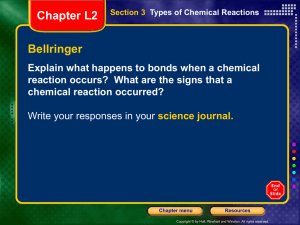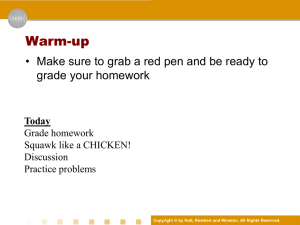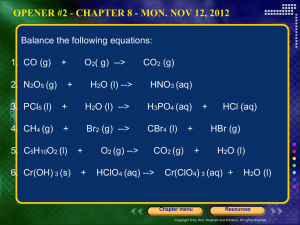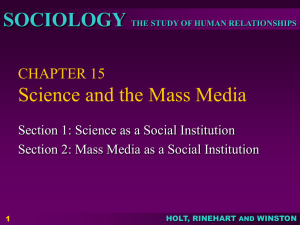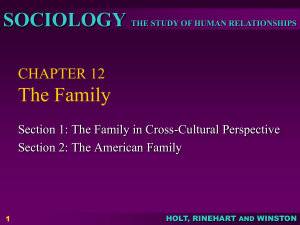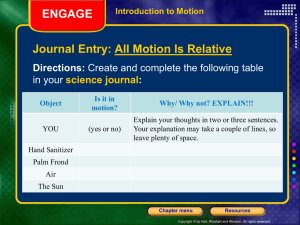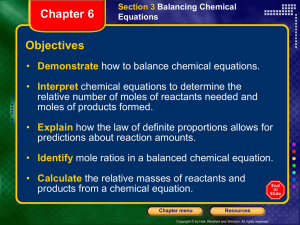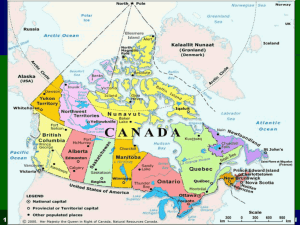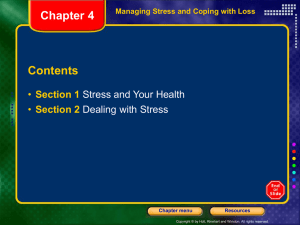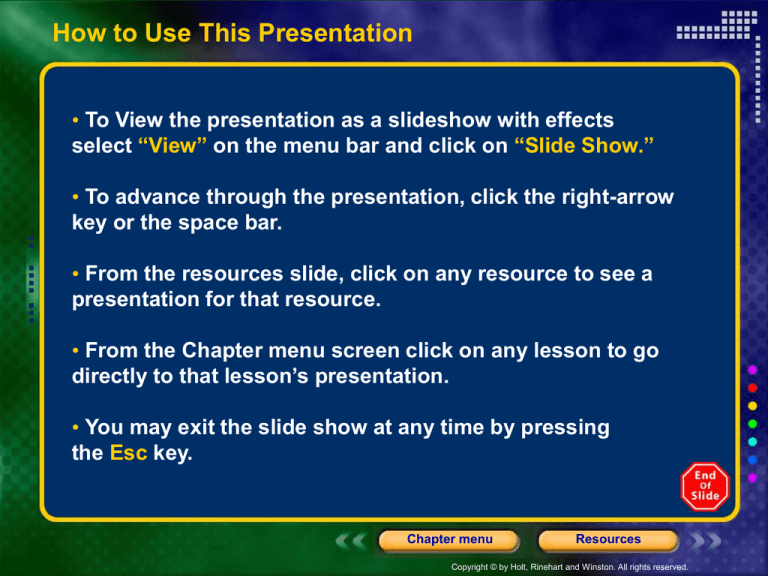
How to Use This Presentation
• To View the presentation as a slideshow with effects
select “View” on the menu bar and click on “Slide Show.”
• To advance through the presentation, click the right-arrow
key or the space bar.
• From the resources slide, click on any resource to see a
presentation for that resource.
• From the Chapter menu screen click on any lesson to go
directly to that lesson’s presentation.
• You may exit the slide show at any time by pressing
the Esc key.
Chapter menu
Resources
Copyright © by Holt, Rinehart and Winston. All rights reserved.
Resources
Chapter Presentation
Bellringer
Transparencies
Sample Problems
Visual Concepts
Standardized Test Prep
Chapter menu
Resources
Copyright © by Holt, Rinehart and Winston. All rights reserved.
Chapter 8
Chemical Equations and
Reactions
Table of Contents
Section 1 Describing Chemical Reactions
Section 2 Balancing Chemical Equations
Section 3 Classifying Chemical Reactions
Section 4 Writing Net Ionic Equations
Chapter menu
Resources
Copyright © by Holt, Rinehart and Winston. All rights reserved.
Chapter 8
Section 1 Describing Chemical
Reactions
Bellringer
For the following situations, list observations that
you think indicate that a chemical reaction has
taken place:
• a cut apple turns brown
• an egg changes when it cooks
• a log burns
• a car rusts
Chapter menu
Resources
Copyright © by Holt, Rinehart and Winston. All rights reserved.
Chapter 8
Section 1 Describing Chemical
Reactions
Objectives
• List evidence that suggests that a chemical reaction
has occurred and evidence that proves that a
chemical reaction has occurred.
• Describe a chemical reaction by using a word
equation and a formula equation.
• Interpret notations in formula equations, such as
those relating to states of matter or reaction
conditions.
Chapter menu
Resources
Copyright © by Holt, Rinehart and Winston. All rights reserved.
Chapter 8
Section 1 Describing Chemical
Reactions
Chemical Reaction
• A chemical reaction is the process by which one or
more substances change into one or more new
substances.
• Reactants are the original substances in a chemical
reaction.
• Products are the substances that are created in a
chemical reaction.
Chapter menu
Resources
Copyright © by Holt, Rinehart and Winston. All rights reserved.
Chapter 8
Visual Concepts
Chemical Reaction
Chapter menu
Resources
Copyright © by Holt, Rinehart and Winston. All rights reserved.
Chapter 8
Section 1 Describing Chemical
Reactions
Evidence of a Chemical Reaction
Chapter menu
Resources
Copyright © by Holt, Rinehart and Winston. All rights reserved.
Chapter 8
Visual Concepts
Signs of a Chemical Reaction
Chapter menu
Resources
Copyright © by Holt, Rinehart and Winston. All rights reserved.
Chapter 8
Visual Concepts
Precipitate
Chapter menu
Resources
Copyright © by Holt, Rinehart and Winston. All rights reserved.
Chapter 8
Section 1 Describing Chemical
Reactions
Evidence of a Chemical Reaction
• solution color changes
• solution bubbles
• copper is used up
Chapter menu
Resources
Copyright © by Holt, Rinehart and Winston. All rights reserved.
Chapter 8
Section 1 Describing Chemical
Reactions
Chemical Reaction Versus Physical Change
• chemical change – new substance forms with
properties that differ from original substance
• density
• boiling point
• melting point
• physical change - changes of state
• evaporation
• condensation
• melting
• freezing
Chapter menu
Resources
Copyright © by Holt, Rinehart and Winston. All rights reserved.
Chapter 8
Section 1 Describing Chemical
Reactions
Reactions and Energy Changes
• Energy can be released in a chemical reaction.
methane + oxygen carbon dioxide + water + energy
Energy is a product.
• Energy can be absorbed in a chemical reaction.
dinitrogen tetroxide + energy nitrogen dioxide
Energy is a reactant.
Chapter menu
Resources
Copyright © by Holt, Rinehart and Winston. All rights reserved.
Chapter 8
Section 1 Describing Chemical
Reactions
Constructing a Chemical Equation
• A chemical equation shows the chemical formulas
and relative amounts of all reactants and products.
• A word equation contains the names of the reactants
and products.
• Equations must be balanced.
Chapter menu
Resources
Copyright © by Holt, Rinehart and Winston. All rights reserved.
Chapter 8
Section 1 Describing Chemical
Reactions
Writing a Word Equation or Formula Equation
methane + oxygen carbon dioxide + water
?CH4
+
?O2
?CO2
+ ?H2O
Chapter menu
Resources
Copyright © by Holt, Rinehart and Winston. All rights reserved.
Section 1 Describing Chemical
Reactions
Chapter 8
Equations and Reaction Information
• Physical States
NaHCO3(s) + HC2H3O2(aq) NaC2H3O2(aq) + CO2(aq) + H2O(l)
solid
liquid
aqueous solutions
• Reaction Conditions
350°C, 25 000 kPa
N2(g) + 3H2(g)
2NH3(g)
catalyst
Chapter menu
Resources
Copyright © by Holt, Rinehart and Winston. All rights reserved.
Chapter 8
Section 1 Describing Chemical
Reactions
Equations and Reaction Information
Chapter menu
Resources
Copyright © by Holt, Rinehart and Winston. All rights reserved.
Chapter 8
Visual Concepts
Chemical Equation
Chapter menu
Resources
Copyright © by Holt, Rinehart and Winston. All rights reserved.
Chapter 8
Section 2 Balancing Chemical
Equations
Bellringer
• Write a word equation for baking a cake.
• Does the cake have the same properties as the
ingredients?
• Answer:
sugar + flour + eggs + vanilla + salt cake
The properties are different.
Chapter menu
Resources
Copyright © by Holt, Rinehart and Winston. All rights reserved.
Chapter 8
Section 2 Balancing Chemical
Equations
Objectives
• Relate the conservation of mass to the
rearrangement of atoms in a chemical reaction.
• Write and interpret a balanced chemical equation for
a reaction, and relate conservation of mass to the
balanced equation.
Chapter menu
Resources
Copyright © by Holt, Rinehart and Winston. All rights reserved.
Chapter 8
Section 2 Balancing Chemical
Equations
Reactions Conserve Mass
• Mass cannot be created or destroyed by a chemical
or physical change
• Equations must be balanced.
?Na + ?H2O ?NaOH + ?H2
Chapter menu
Resources
Copyright © by Holt, Rinehart and Winston. All rights reserved.
Chapter 8
Section 2 Balancing Chemical
Equations
Balancing Equations
• The number of atoms for each element must be the
same on the reactants’ side and on the products’
side.
• A coefficient multiplies the number of atoms of each
element in the formula that follows.
H2O: 2 hydrogen atoms, 1 oxygen atom
2H2O: 4 hydrogen atoms, 2 oxygen atoms
Chapter menu
Resources
Copyright © by Holt, Rinehart and Winston. All rights reserved.
Chapter 8
Visual Concepts
Reading a Chemical Equation
Chapter menu
Resources
Copyright © by Holt, Rinehart and Winston. All rights reserved.
Chapter 8
Visual Concepts
Balancing a Chemical Equation by Inspection
Chapter menu
Resources
Copyright © by Holt, Rinehart and Winston. All rights reserved.
Chapter 8
Section 2 Balancing Chemical
Equations
Balancing Equations
Sample Problem A
Balance the equation for the reaction of iron(III) oxide
with hydrogen to form iron and water.
Chapter menu
Resources
Copyright © by Holt, Rinehart and Winston. All rights reserved.
Chapter 8
Section 2 Balancing Chemical
Equations
Balancing Equations
Sample Problem A Solution
1. Identify reactants and products.
reactants
products
Fe2O3 + 3 H2 2 Fe + 3 H2O
2. Count atoms
Reactants
Products Balanced?
Fe2O3 + H2
Fe + H2O
Iron atoms
2
1
no
Oxygen atoms
3
1
no
Hydrogen atoms
2
2
yes
Unbalanced formula equation
3. Insert coefficients.
Chapter menu
Resources
Copyright © by Holt, Rinehart and Winston. All rights reserved.
Chapter 8
Section 2 Balancing Chemical
Equations
Reactions Conserve Mass
• Balanced equations show mass conservation
?Na + ?H2O ?NaOH + ?H2
2Na + 2H2O 2NaOH + H2
• Never change subscripts to balance equations
Unbalanced: H2 + O2 H2O
Incorrect:
H2 + O2 H2O2
H2O H2O2
Correct:
2H2 + O2 2H2O
Chapter menu
Resources
Copyright © by Holt, Rinehart and Winston. All rights reserved.
Chapter 8
Section 2 Balancing Chemical
Equations
Reactions Conserve Mass
Chapter menu
Resources
Copyright © by Holt, Rinehart and Winston. All rights reserved.
Chapter 8
Section 2 Balancing Chemical
Equations
Polyatomic Ions can be balanced as a group
Chapter menu
Resources
Copyright © by Holt, Rinehart and Winston. All rights reserved.
Chapter 8
Section 2 Balancing Chemical
Equations
Balancing Equations
Sample Problem C
Aluminum reacts with arsenic acid, HAsO3, to form H2
and aluminum arsenate. Write a balanced equation for
this reaction.
Chapter menu
Resources
Copyright © by Holt, Rinehart and Winston. All rights reserved.
Chapter 8
Section 2 Balancing Chemical
Equations
Balancing Equations
Sample Problem C Solution
1. Identify reactants and products.
reactants
products
2 Al + 6HAsO3 3H2 + 2 Al(AsO3)3
2. Count Atoms
Reactants
Products
Al + HAsO3
H2 + Al(AsO3)3
Iron atoms
1
1
yes
Oxygen atoms
1
2
no
Hydrogen atoms
1
3
no
Unbalanced formula equation
Balanced?
3. Insert coefficients
Chapter menu
Resources
Copyright © by Holt, Rinehart and Winston. All rights reserved.
Chapter 8
Section 3 Classifying Chemical
Reactions
Bellringer
• Describe the following terms.
• synthesis
• decomposition
• displacement
Chapter menu
Resources
Copyright © by Holt, Rinehart and Winston. All rights reserved.
Chapter 8
Section 3 Classifying Chemical
Reactions
Objectives
• Identify combustion reactions, and write chemical
equations that predict the products.
• Identify synthesis reactions, and write chemical
equations that predict the products.
• Identify decomposition reactions, and write chemical
equations that predict the products.
Chapter menu
Resources
Copyright © by Holt, Rinehart and Winston. All rights reserved.
Chapter 8
Section 3 Classifying Chemical
Reactions
Objectives, continued
• Identify displacement reactions, and use the activity
series to write chemical equations that predict the
products.
• Identify double-displacement reactions, and write
chemical equations that predict the products.
Chapter menu
Resources
Copyright © by Holt, Rinehart and Winston. All rights reserved.
Chapter 8
Section 3 Classifying Chemical
Reactions
Combustion Reactions
• A combustion reaction is a reaction of a carbonbased compound with oxygen.
Combustion of propane:
C3H8 + 5O2 3CO2 + 4H2O
Combustion of ethanol:
CH3CH2OH + 3O2 2CO2 + 3H2O
Chapter menu
Resources
Copyright © by Holt, Rinehart and Winston. All rights reserved.
Chapter 8
Visual Concepts
Combustion Reaction
Chapter menu
Resources
Copyright © by Holt, Rinehart and Winston. All rights reserved.
Chapter 8
Section 3 Classifying Chemical
Reactions
Synthesis Reactions
• In a synthesis reaction a single compound forms
from two or more reactants.
• Two elements form a binary compound
C + O2 CO2
2C + O2 2CO
• Two compounds form a ternary compound
CaO(s) + H2O(l) Ca(OH)2(s)
CO2(g) + H2O(l) H2CO3(aq)
Chapter menu
Resources
Copyright © by Holt, Rinehart and Winston. All rights reserved.
Chapter 8
Visual Concepts
Synthesis Reactions
Chapter menu
Resources
Copyright © by Holt, Rinehart and Winston. All rights reserved.
Chapter 8
Section 3 Classifying Chemical
Reactions
Decomposition Reactions
• In a decomposition reaction a single compound
breaks down, often with the input of energy, into two
or more elements or simpler compounds.
• Decomposition of water
2H2O(l)
electricity
O2(g) + 2H2(g)
• A metal carbonate decomposes to form a metal
oxide and carbon dioxide.
CaCO3(s)
heat
CaO(s) + CO2(g)
Chapter menu
Resources
Copyright © by Holt, Rinehart and Winston. All rights reserved.
Chapter 8
Visual Concepts
Decomposition Reaction
Chapter menu
Resources
Copyright © by Holt, Rinehart and Winston. All rights reserved.
Chapter 8
Visual Concepts
Electrolysis
Chapter menu
Resources
Copyright © by Holt, Rinehart and Winston. All rights reserved.
Chapter 8
Section 3 Classifying Chemical
Reactions
Decomposition Reactions, continued
Sample Problem D
Predicting Products
Predict the product(s) and write a balanced equation
for the reaction of potassium with chlorine.
Chapter menu
Resources
Copyright © by Holt, Rinehart and Winston. All rights reserved.
Chapter 8
Section 3 Classifying Chemical
Reactions
Decomposition Reactions, continued
Sample Problem D Solution
• Reaction is most likely a synthesis reaction, so the
product will be binary
• Potassium will lose one electron to become a 1+ ion.
• Chlorine will gain one electron to become a 1– ion.
K + Cl2 KCl
• Balance the equation.
2K + Cl2 2KCl
Chapter menu
Resources
Copyright © by Holt, Rinehart and Winston. All rights reserved.
Chapter 8
Section 3 Classifying Chemical
Reactions
Displacement Reactions
• In a displacement reaction a single element reacts
with a compound and displaces another element
from the compound.
2Al(s) + 3CuCl2(aq) 2AlCl3(aq) + 3Cu(s)
Aluminum displaces copper.
Chapter menu
Resources
Copyright © by Holt, Rinehart and Winston. All rights reserved.
Chapter 8
Visual Concepts
Single Displacement Reaction
Chapter menu
Resources
Copyright © by Holt, Rinehart and Winston. All rights reserved.
Chapter 8
Section 3 Classifying Chemical
Reactions
Displacement Reactions, continued
• The activity series ranks the reactivity of elements
Chapter menu
Resources
Copyright © by Holt, Rinehart and Winston. All rights reserved.
Chapter 8
Visual Concepts
Activity Series
Chapter menu
Resources
Copyright © by Holt, Rinehart and Winston. All rights reserved.
Chapter 8
Section 3 Classifying Chemical
Reactions
Displacement Reactions, continued
Sample Problem E
Determining Products by Using the Activity Series
Magnesium is added to a solution of lead(II) nitrate.
Will a reaction happen? If so, write the equation and
balance it.
Chapter menu
Resources
Copyright © by Holt, Rinehart and Winston. All rights reserved.
Chapter 8
Section 3 Classifying Chemical
Reactions
Displacement Reactions, continued
Sample Problem E Solution
1. Identify the reactants.
Magnesium will attempt to displace lead from
lead(II) nitrate.
2. Check the activity series.
Magnesium is more active than lead and displaces
it.
3. Write the balanced equation.
Mg + Pb(NO3)2 Pb + Mg(NO3)2
Chapter menu
Resources
Copyright © by Holt, Rinehart and Winston. All rights reserved.
Chapter 8
Section 3 Classifying Chemical
Reactions
Double-Displacement Reactions
• In a double-displacement reaction two compounds in
aqueous solution appear to exchange ions and form
two new compounds.
• One of the products must be a solid precipitate, a
gas, or a molecular compound, such as water.
HCl(aq) + NaOH(aq) HOH(l) + NaCl(aq)
Chapter menu
Resources
Copyright © by Holt, Rinehart and Winston. All rights reserved.
Chapter 8
Visual Concepts
Double-Displacement Reaction
Chapter menu
Resources
Copyright © by Holt, Rinehart and Winston. All rights reserved.
Chapter 8
Visual Concepts
Precipitation Reaction
Chapter menu
Resources
Copyright © by Holt, Rinehart and Winston. All rights reserved.
Chapter 8
Identifying
Reactions and
Predicting Products
Chapter menu
Resources
Copyright © by Holt, Rinehart and Winston. All rights reserved.
Chapter 8
Section 4 Writing Net Ionic
Equations
Bellringer
• Write a definition for the word spectator in terms
of the part spectators play in a sporting event.
Chapter menu
Resources
Copyright © by Holt, Rinehart and Winston. All rights reserved.
Chapter 8
Section 4 Writing Net Ionic
Equations
Objectives
• Write total ionic equations for reactions in aqueous
solutions.
• Identify spectator ions and write net ionic equations
for reactions in aqueous solutions.
Chapter menu
Resources
Copyright © by Holt, Rinehart and Winston. All rights reserved.
Chapter 8
Section 4 Writing Net Ionic
Equations
Ionic Equations, continued
• Ionic compounds dissolve in water
KI(aq) = K+(aq) + I–(aq)
Pb(NO3)2(aq) = Pb2+(aq) + 2NO3(aq)
• Reaction between KI and Pb(NO3)2
2KI(aq) + Pb(NO3)2(aq) PbI2(s) + 2KNO3(aq)
• Total Ionic Equation
2K+(aq) + 2I–(aq) + Pb2+(aq) + 2NO3 (aq)
PbI2(s) + 2K+(aq) + 2NO3 (aq)
Chapter menu
Resources
Copyright © by Holt, Rinehart and Winston. All rights reserved.
Chapter 8
Section 4 Writing Net Ionic
Equations
Ionic Equations, continued
• Spectator ions remain unchanged in the solution as
aqueous ions. They do not react.
2K+(aq) + 2I–(aq) + Pb2+(aq) + 2NO3(aq)
PbI2(s) + 2K+(aq) + 2NO3 (aq)
• The net ionic equation is the chemical equation that
shows only the net change.
2I–(aq) + Pb2+(aq) PbI2(s)
Chapter menu
Resources
Copyright © by Holt, Rinehart and Winston. All rights reserved.
Chapter 8
Visual Concepts
Net Ionic Equation
Chapter menu
Resources
Copyright © by Holt, Rinehart and Winston. All rights reserved.
Chapter 8
Section 4 Writing Net Ionic
Equations
Ionic Equations, continued
• Net Ionic equations can be used for displacement
reactions.
Zn(s) + Cu2+(aq) + SO24 (aq)
Cu(s) + Zn2+(aq) + SO2(aq)
4
• net ionic equation
• Zn(s) + Cu2+(aq) Cu(s) + Zn2+(aq)
Chapter menu
Resources
Copyright © by Holt, Rinehart and Winston. All rights reserved.
Chapter 8
Section 4 Writing Net Ionic
Equations
Ionic Equations, continued
• Check atoms and charge to balance net ionic
equations.
SO24 (aq) + Ba2+(aq) BaSO4(s)
Charge:
(2–) + (2+) = 0
0
Zn(s) + Cu2+(aq) Cu(s) + Zn2+(aq)
Charge:
2+
2+
Chapter menu
Resources
Copyright © by Holt, Rinehart and Winston. All rights reserved.
Chapter 8
Writing a Net Ionic Equation
Chapter menu
Resources
Copyright © by Holt, Rinehart and Winston. All rights reserved.
Chapter 8
Standardized Test Preparation
Understanding Concepts
1. What type of chemical reaction involves the exchange
of the ions of two compounds in an aqueous solution to
form two new compounds?
A. synthesis reaction
B. decomposition reaction
C. single-displacement reaction
D. double-displacement reaction
Chapter menu
Resources
Copyright © by Holt, Rinehart and Winston. All rights reserved.
Chapter 8
Standardized Test Preparation
Understanding Concepts
1. What type of chemical reaction involves the exchange
of the ions of two compounds in an aqueous solution to
form two new compounds?
A. synthesis reaction
B. decomposition reaction
C. single-displacement reaction
D. double-displacement reaction
Chapter menu
Resources
Copyright © by Holt, Rinehart and Winston. All rights reserved.
Chapter 8
Standardized Test Preparation
Understanding Concepts
2. Which of these sentences correctly states the law of
conservation of mass?
F.
In a chemical reaction, the mass of the products cannot
exceed the mass of the reactants.
G.
In a chemical reaction, the mass of the products is
always equal to the mass of the reactants.
H.
In a chemical reaction, the mass of the products is
always less than the mass of the reactants.
I.
In a chemical reaction, the mass of the products is
always greater than the mass of the reactants.
Chapter menu
Resources
Copyright © by Holt, Rinehart and Winston. All rights reserved.
Chapter 8
Standardized Test Preparation
Understanding Concepts
2. Which of these sentences correctly states the law of
conservation of mass?
F.
In a chemical reaction, the mass of the products cannot
exceed the mass of the reactants.
G.
In a chemical reaction, the mass of the products is
always equal to the mass of the reactants.
H.
In a chemical reaction, the mass of the products is
always less than the mass of the reactants.
I.
In a chemical reaction, the mass of the products is
always greater than the mass of the reactants.
Chapter menu
Resources
Copyright © by Holt, Rinehart and Winston. All rights reserved.
Chapter 8
Standardized Test Preparation
Understanding Concepts
3. Of these reaction types, which has only one reactant?
A. decomposition
B. displacement
C. oxidation
D. synthesis
Chapter menu
Resources
Copyright © by Holt, Rinehart and Winston. All rights reserved.
Chapter 8
Standardized Test Preparation
Understanding Concepts
3. Of these reaction types, which has only one reactant?
A. decomposition
B. displacement
C. oxidation
D. synthesis
Chapter menu
Resources
Copyright © by Holt, Rinehart and Winston. All rights reserved.
Chapter 8
Standardized Test Preparation
Understanding Concepts
4. Write a net ionic equation, excluding spectator ions, for
the reaction:
Mg(s) + Zn(NO3)2(aq) Zn(s) + Mg(NO3)2(aq)
Chapter menu
Resources
Copyright © by Holt, Rinehart and Winston. All rights reserved.
Chapter 8
Standardized Test Preparation
Understanding Concepts
4. Write a net ionic equation, excluding spectator ions, for
the reaction:
Mg(s) + Zn(NO3)2(aq) Zn(s) + Mg(NO3)2(aq)
Answer: Mg(s) + Zn2+(aq) Mg2+(aq) + Zn(s)
Chapter menu
Resources
Copyright © by Holt, Rinehart and Winston. All rights reserved.
Chapter 8
Standardized Test Preparation
Understanding Concepts
5. Differentiate between formula equations and balanced
chemical equations.
Chapter menu
Resources
Copyright © by Holt, Rinehart and Winston. All rights reserved.
Chapter 8
Standardized Test Preparation
Understanding Concepts
5. Differentiate between formula equations and balanced
chemical equations.
Answer: Formula equations give the identity of the
reactants and the products, but a balanced equation
shows equal numbers of atoms of each element on
both sides.
Chapter menu
Resources
Copyright © by Holt, Rinehart and Winston. All rights reserved.
Chapter 8
Standardized Test Preparation
Understanding Concepts
6. Write a balanced equation for this reaction:
iron(III) nitrate + lithium hydroxide
lithium nitrate + iron(III) hydroxide
Chapter menu
Resources
Copyright © by Holt, Rinehart and Winston. All rights reserved.
Chapter 8
Standardized Test Preparation
Understanding Concepts
6. Write a balanced equation for this reaction:
iron(III) nitrate + lithium hydroxide
lithium nitrate + iron(III) hydroxide
Answer: Fe(NO3)3 + 3LiOH 3LiNO3 + Fe(OH)3
Chapter menu
Resources
Copyright © by Holt, Rinehart and Winston. All rights reserved.
Chapter 8
Standardized Test Preparation
Reading Skills
Read the passage below. Then answer the questions.
A student places a strip of pure magnesium metal
into a test tube containing a dilute solution of
hydrochloric acid (hydrogen chloride dissolved in
water). As the magnesium disappears, bubbles of a
colorless gas form and the test tube becomes hot to the
touch. If a lit match is placed near the top of the test
tube, the gas that has been generated burns.
Chapter menu
Resources
Copyright © by Holt, Rinehart and Winston. All rights reserved.
Chapter 8
Standardized Test Preparation
Reading Skills
7. What evidence is there that a chemical reaction has
occurred?
Chapter menu
Resources
Copyright © by Holt, Rinehart and Winston. All rights reserved.
Chapter 8
Standardized Test Preparation
Reading Skills
7. What evidence is there that a chemical reaction has
occurred?
Answer: The gas that burns is a different chemical
substance than any of the reactants, indicating a
chemical reaction.
Chapter menu
Resources
Copyright © by Holt, Rinehart and Winston. All rights reserved.
Chapter 8
Standardized Test Preparation
Reading Skills
8. Based on the substances present in the reaction, what
is the most likely identity of the reaction product that
burns in air?
F.
hydrogen
G. magnesium
H. oxygen
I.
oxygen and hydrogen mixture
Chapter menu
Resources
Copyright © by Holt, Rinehart and Winston. All rights reserved.
Chapter 8
Standardized Test Preparation
Reading Skills
8. Based on the substances present in the reaction, what
is the most likely identity of the reaction product that
burns in air?
F.
hydrogen
G. magnesium
H. oxygen
I.
oxygen and hydrogen mixture
Chapter menu
Resources
Copyright © by Holt, Rinehart and Winston. All rights reserved.
Chapter 8
Standardized Test Preparation
Reading Skills
9. Which of these equations is a balanced chemical
equation for the reaction described above?
A.
Mg(s) + HCl(aq) MgCl2(aq) + H2(g) + energy
B.
Mg(s) + 2HCl(aq) + energy MgCl2(aq) + H2(g)
C. Mg(s) + 2HCl(aq) MgCl2(aq) + H2(g) + energy
D. 2Mg(s) + 2HCl(aq) 2MgCl2(aq) + H2(g) + energy
Chapter menu
Resources
Copyright © by Holt, Rinehart and Winston. All rights reserved.
Chapter 8
Standardized Test Preparation
Reading Skills
9. Which of these equations is a balanced chemical
equation for the reaction described above?
A.
Mg(s) + HCl(aq) MgCl2(aq) + H2(g) + energy
B.
Mg(s) + 2HCl(aq) + energy MgCl2(aq) + H2(g)
C. Mg(s) + 2HCl(aq) MgCl2(aq) + H2(g) + energy
D. 2Mg(s) + 2HCl(aq) 2MgCl2(aq) + H2(g) + energy
Chapter menu
Resources
Copyright © by Holt, Rinehart and Winston. All rights reserved.
Chapter 8
Standardized Test Preparation
Interpreting Graphics
The table below shows the reactivity of selected
elements. Use it to answer questions 10 through 12.
Chapter menu
Resources
Copyright © by Holt, Rinehart and Winston. All rights reserved.
Chapter 8
Standardized Test Preparation
Interpreting Graphics
10.Which of these elements will produce a flammable
product when placed in water at room temperature?
F.
aluminum
G. silver
H. sodium
I.
zinc
Chapter menu
Resources
Copyright © by Holt, Rinehart and Winston. All rights reserved.
Chapter 8
Standardized Test Preparation
Interpreting Graphics
10.Which of these elements will produce a flammable
product when placed in water at room temperature?
F.
aluminum
G. silver
H. sodium
I.
zinc
Chapter menu
Resources
Copyright © by Holt, Rinehart and Winston. All rights reserved.
Chapter 8
Standardized Test Preparation
Interpreting Graphics
11.Which of these combinations is most likely to cause a
displacement reaction?
A. a zinc strip placed in a solution of aluminum
chloride
B. a nickel strip placed in a solution of calcium
chloride
C. a silver strip placed in a solution of potassium
hydroxide
D. an aluminum strip placed in a solution of copper
chloride
Chapter menu
Resources
Copyright © by Holt, Rinehart and Winston. All rights reserved.
Chapter 8
Standardized Test Preparation
Interpreting Graphics
11.Which of these combinations is most likely to cause a
displacement reaction?
A. a zinc strip placed in a solution of aluminum
chloride
B. a nickel strip placed in a solution of calcium
chloride
C. a silver strip placed in a solution of potassium
hydroxide
D. an aluminum strip placed in a solution of copper
chloride
Chapter menu
Resources
Copyright © by Holt, Rinehart and Winston. All rights reserved.
Chapter 8
Standardized Test Preparation
Interpreting Graphics
12.What determines the order of the elements in the
activity series?
F.
increasing atomic number
G. increasing electronegativity
H. increasing ionization energy
I.
experimentally determined reactivity
Chapter menu
Resources
Copyright © by Holt, Rinehart and Winston. All rights reserved.
Chapter 8
Standardized Test Preparation
Interpreting Graphics
12.What determines the order of the elements in the
activity series?
F.
increasing atomic number
G. increasing electronegativity
H. increasing ionization energy
I.
experimentally determined reactivity
Chapter menu
Resources
Copyright © by Holt, Rinehart and Winston. All rights reserved.

